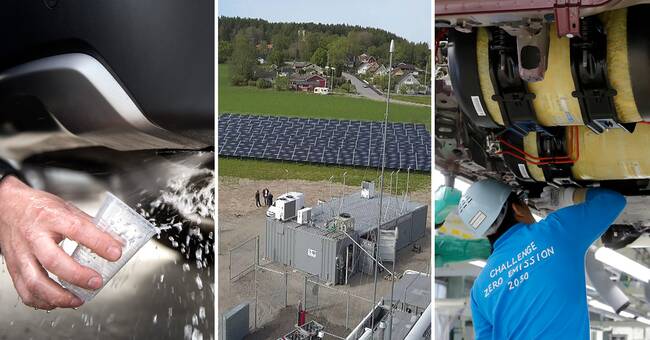Statement: The vehicles of the future will be powered by fuel cells
The "hydrogen car" is an electric car where the batteries are replaced with a gas tank and a fuel cell.
In the fuel cell, the energy in the hydrogen gas is converted by means of air into electricity that drives the car's engine.
In addition, heat and "exhaust gases" occur in the form of clean water.
In the fuel cell, a chemical reaction takes place between the hydrogen gas and the oxygen in the air.
The result is electricity, which can drive an electric car, for example, and the residual product water vapor.
Photo: Ayman Alkassab, SVT Grafik
A fuel cell car today has an efficiency of approximately 50 percent.
Thus significantly better at utilizing energy than internal combustion engines (petrol, diesel, ethanol, vehicle gas) but worse than a battery-powered electric car, where over 80 percent of the energy is used to power the car.
On the other hand, the range is better - up to 700 km on a tank of hydrogen.
For a battery car to reach the same distance on one charge, very large and expensive batteries are required.
For freight transport, fuel cells look like a better solution than the huge batteries needed to power an electric truck.
Another benefit is a hydrogen tank fills up in minutes while a battery car takes many hours to charge.
At fast charging stations, there may be queues and waiting times as the number of users increases.
Water and heat - in practice water vapor - are the only "exhaust gases" that a fuel cell leaves behind.
The same amount of water that was used to produce the hydrogen gas returns when the fuel cell extracts the stored energy.
Photo: Pontus Lindahl, TT arikv
Statement: Fuel cell cars are expensive and gas stations are missing
Despite the fact that there has been talk of fuel cell cars for more than 30 years, no more than forty people are rolling on Swedish roads.
One reason has been that the cars could not be obtained, and
if
it had been possible, the cheapest would have cost at least SEK 750,000.
Another reason is that there are only four places in Sweden where it is possible to refuel with hydrogen.
Should the gas station at Arlanda be out of order, the nearest alternative is in Sandviken, sixteen miles and almost two hours' drive away.
It is sparse between the hydrogen gas stations in Sweden.
One of the reasons why technology can not break through.
In other countries, the plans have gone much further.
Photo: Lars Sander, SVT graphics
Norway Denmark and Germany are significantly further ahead.
Now they want to build "corridors" of filling stations so that it will at least be possible to drive your fuel cell car along the major roads without risking being left with an empty tank.
Leading the development is Japan, where there is a national strategy for building energy systems on hydrogen.
A fuel cell car with hydrogen tanks is mounted in Toyota's Motomachi factory.
Ahead of the Summer Olympics in Tokyo 2020, Japan is preparing a major investment in fuel cells.
Photo: Yuri Kageyama, TT
But building a new functioning transport chain and more filling stations for hydrogen would be very expensive.
Hydrogen is bulky and difficult to handle and transport.
A lot of money must also be invested in research and development.
There is much to suggest that hydrogen and fuel cell operation will be more expensive than battery operation for a long time to come.
At the same time, battery-powered electric cars will also require large investments and a partly new infrastructure as they become more numerous.
The electricity networks in most cities do not have sufficient capacity to charge so many cars.
The likely future scenario is that both vehicle types will exist in parallel.
Battery vehicles for shorter journeys and fuel cells for heavier and longer-distance transports.
For heavy transports, fuel cells have advantages over batteries - they are quick to refuel and have a low weight in relation to the range.
Photo: Jae C. Hong, TT
Claim: Producing hydrogen is a waste of energy and bad for the environment
Hydrogen is not an energy source but an energy carrier that can store, for example, solar energy.
At the same time, energy is consumed during production, when the water molecule is broken down into oxygen and hydrogen.
30-40 percent of the energy is lost during the process in the form of heat.
With the help of electricity, the water molecule is broken down into its two constituents hydrogen and oxygen.
By saving the hydrogen gas, you can store green energy for later use.
Photo: Ayman Alkassab, SVT Grafik
Even in the fuel cell, energy is lost.
In a car, this can be an advantage as the excess heat can be used to heat the passenger compartment, something that a battery car cannot do without losing range.
Fuel cells can also be used in other than vehicles - for example to produce electricity locally and at the same time heat homes.
Even in heavy industrial processes, the use of hydrogen may play an important role in reducing climate impact.
This applies, among other things, to steel production and in the cement industry, which today is behind large emissions of greenhouse gases.
Whether hydrogen production is environmentally harmful or not depends on how the electricity used in the production is produced.
Today, hydrogen is produced mainly from natural gas, which creates large emissions.
In the future, the idea is that surpluses from wind and solar power will be stored in the form of hydrogen.
Advocates talk about how a hydrogen society should replace today's petroleum society.

